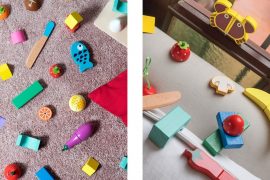[dropcap letter=”A”]
re you really surprised that Tintin stepped on the Moon seventeen years before Neil Armstrong did? The truth is that Hergé was a methodical draftsman, who planned his graphic stories in the smallest detail. He documented in depth about each and every one of the aspects he wanted to show on his albums. The adventures of the intrepid reporter and his dog Milú capture the reader’s attention because they are real. Tintin lives in a vignette, but also in our world and the trip he made in the years 1950-1952 (in fascicles), and that the American space agency copied in 1969, is a clear sign.
Have you ever thought why at the Tintin’s Moon do not appear for example fantastic animals, UFOs or aliens? Its author wanted that when flesh and blood men went to the Moon, outside the vignettes, they would arrive at the same place where his character had already been
Do you remember the rocket that illustrates the cover of Destination Moon, red and white checked, to which Tintin and his dog approach, accompanied by Captain Haddock and Professor Tornasol? Its design is based on a ballistic missile, V2 rocket, that the Nazis developed at the beginning of the Second World War and that caused the death of more than seven thousand people, civilians and military, in London and Antwerp.

Hergé used those photographs to invent a less deadly engine. But he did not stop there, when realizing his double lunar album, completed by the volume Explorers on the Moon. He consulted numerous press reports about the man’s attempt to reach his satellite, read books by popular science fiction writer Pierre Rousseau and physicist Auguste Piccard, and also L’Astronautique published in 1950 in which the physicist Alexander Ananoff spoke of the Trip to space. He even corresponded with him. The artist also visited scientific research centers to get inspired.
All this information was useful to Hergé, thanks to the help of collaborators like the Belgian cryptozoologist Bernard Heuvelmans and the writer Jacques van Melkebeke, to give shape to some loose ideas, which at the beginning of 1948 were reduced to Haddock’s sketches trying to drink whiskey in a context of weightlessness. Have you ever thought why at the Tintin’s Moon do not appear for example fantastic animals, UFOs or aliens? Its author wanted that when flesh and blood men went to the Moon, outside the vignettes, they would arrive at the same place where his character had already been.
 Otherwise the excellent exhibition that welcomes CosmoCaixa Tintin and the Moon. 50 years of the first manned mission would not have been possible. Had they read the double album of Hergé Neil Armstrong, Buzz Aldrin -who also stepped on the satellite – and Michael Collins when they landed? Even the words “that’s one small step for a man, one giant leap for mankind this is a small step for man, a great step for Humanity” recall those of Tintin upon his arrival: “for the first time in the history of Humanity there is an explorer on the Moon”. Let us reflect, by any chance were they their inspiration?
Otherwise the excellent exhibition that welcomes CosmoCaixa Tintin and the Moon. 50 years of the first manned mission would not have been possible. Had they read the double album of Hergé Neil Armstrong, Buzz Aldrin -who also stepped on the satellite – and Michael Collins when they landed? Even the words “that’s one small step for a man, one giant leap for mankind this is a small step for man, a great step for Humanity” recall those of Tintin upon his arrival: “for the first time in the history of Humanity there is an explorer on the Moon”. Let us reflect, by any chance were they their inspiration?
The exhibition that can be visited until next May 26th brings together the two realities, that of Milú’s friends and that of the Apolo XI, to commemorate July 20th, 1969, half a century since the arrival of a manned mission to the Moon -or the Hollywood montage, depending on who explains you the story. There are life-size reconstructions of the Eagle lunar module with which Aldrin and Armstrong descended to the lunar surface and the Columbia module with which the three astronauts returned back to Earth. Even if it is not with a whiskey, the visitor can experience gravity on the Moon and observe its landscape.
Visitors can also see a fragment of the Moon, just like that. The American crew was a couple of hours collecting samples. Not so long, compared to the two weeks that Tintin spent, who even found that there was water
The exhibition also reviews human aspirations, the Galileo studies and a reproduction of his 1609 telescope, as well as ideas for when may be possible to establish a colony or go on space tourism. And, of course, the exhibition shows that there have been other missions to the Moon after the most well-known one, although one does not have the habit to think about it.
Visitors can also see a fragment of the Moon, just like that. The American crew was a couple of hours collecting samples. Not so long, compared to the two weeks that Tintin spent, who even found that there was water. Dresses, Hergé sketches, objects to travel to space, some of which are as prosaic as toothpaste or a bag to collect the astronauts’ excrements. All this and, above all, the possibility of verifying that what we imagine one day can become reality make the visit to the CosmoCaixa a must of this winter.


















